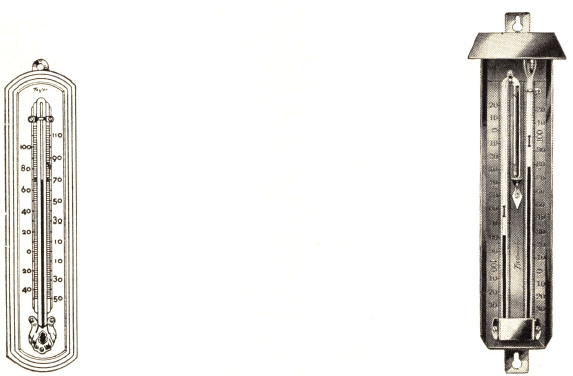Centigrade and Fahrenheit Scales
The value of the Centigrade degree is 1.8 times that of the Fahrenheit degree. Hence to convert ° C. to 0 F. multiply by 1.8 and then add 32° (since 0° C. = 32° F.) To convert 0 F. to ° C., the process is reversed: Subtract 32°, then divide by 1.8.
Correction for Emergent Stem
Unless otherwise specified thermometers are calibrated for total immersion, that is, they give true readings when immersed up to the level of the mercury. In certain cases it is not feasible to immerse the thermometer up to this point, making it necessary to correct for the emergent stem. In order to apply this correction, the approximate temperature of the emergent stem must be determined by means of an auxiliary thermometer hung near the middle of the stem. The following empirical formula has been worked out for the average high-grade thermometer:
If either N or (T° —1°) is large the corrected temperature (T° + d) should be again substituted for T° in the formula until the result comes within the accuracy of the reading.
THERMOMETER, Chemical—Centigrade scale engraved on stem. Full immersion.
THERMOMETER, Chemical—Fahrenheit scale engraved on stem. Full immersion.
THERMOMETER, Chemical, Precision Grade, Nitrogen-Filled—Fahrenheit scale engraved on stem. For use in armors Nos. 61235 to 61237. For 3-inch immersion. Without armor.
THERMOMETER ARMOR—Of seamless drawn steel tubing, white plated and satin finished. Lower end perforated to permit circulation around the bulb. Without thermometer. Inside bore, 5/16 inch.
THERMOMETER, Pocket—Mounted in polished nickeled brass carrying case with screw cap and pocket clip. Range, 0 to 220° divisions F. in 2° divisions. Length, 5½ inches.
THERMOMETER, Maximum-Registering, Pocket—Mounted in a polished nickeled brass carrying case with screw cap and pocket clip. Range, 0 to 220° F. in 2° divisions. The self-registering feature consists of a contraction in the bore of the tube just above the bulb which permits the column of mercury to rise to the maximum temperature but causes it to break at the contraction when removed from the source of heat, and remain stationary in the bore until shaken back, which is done by holding the thermometer by the top and shaking downward, forcing the mercury in the stem past the contraction in the bore to the bulb. Length, 5½ inches.
THERMOMETER, Outdoor Wall—With Permacolor tube with magnifying lens and outdoor temperature scale. Scale is relief-line finished brass. Back is of hardwood finished in colored lacquer. Height, 8 inches.
THERMOMETER, Maximum and Minimum Registering, Sixe’s, Taylor—This thermometer both reports temperature at the time of reading, and the maximum and minimum reached during any given period. 10-inch lacquered brass, one-piece scale and case, and three leg tube with range from 10° below zero to 120° F. above in 2° divisions. Complete with setting magnet.




